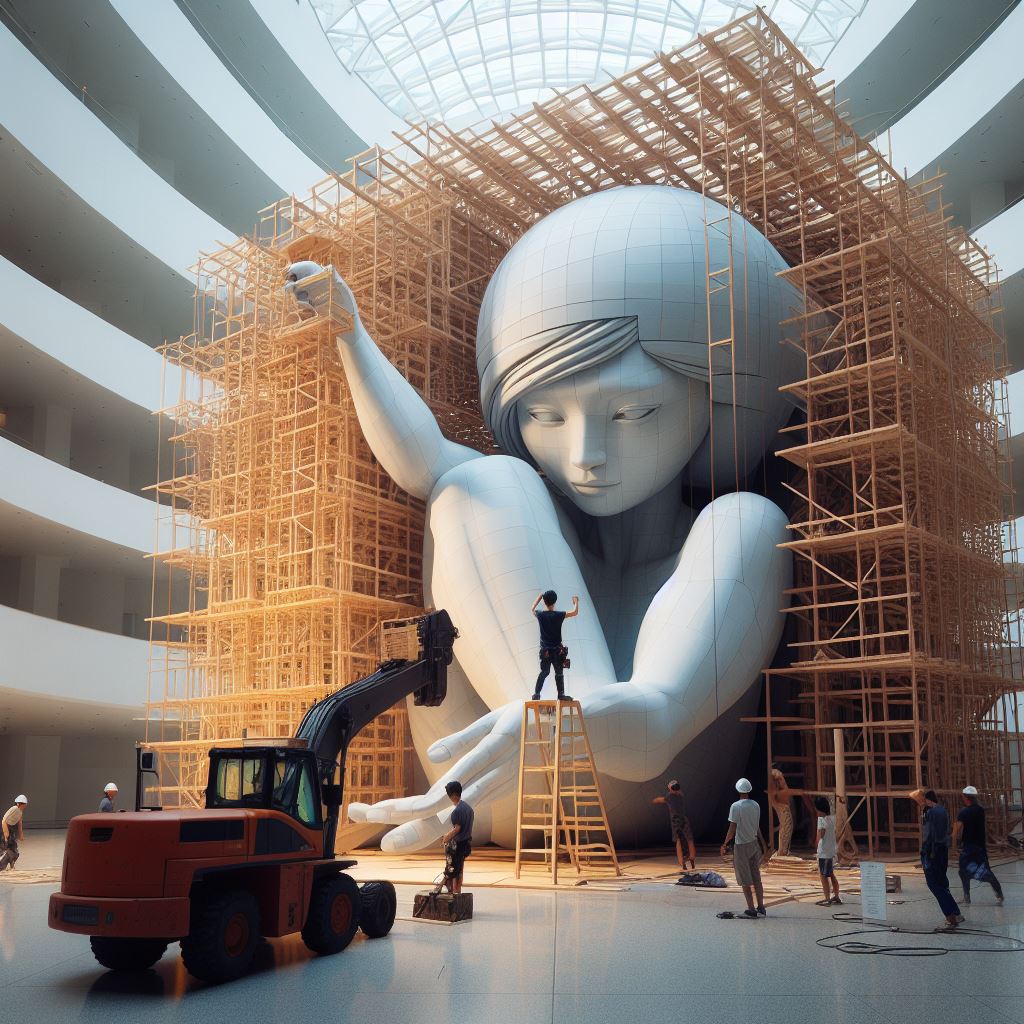Art Installation Machine: Merging Blood and Mechanics
The realm of art continuously evolves, incorporating new themes and materials that challenge the conventional boundaries. Among the most intriguing developments is the emergence of biomechanical art installations, a fusion of organic and mechanical elements that create a surreal and thought-provoking experience. These installations often incorporate the very essence of life—blood—interwoven with mechanical components, crafting a narrative on the interconnectedness of biology and technology.
As the art world delves into this innovative genre, the expertise required to install such complex pieces becomes paramount. With over two decades of experience, TYart has established itself as a leader in the meticulous world of art installation. Crafting environments where art and space converge harmoniously, TYart’s skilled professionals ensure that every biomechanical art installation is executed with precision and care, respecting both the artist’s vision and the delicate interplay of materials involved.
Need Help With Your Corporate Art Installation? TYart is here to help. For years, we’ve been assisting with the installation of eye-catching art, understanding the importance of careful handling and the profound impact these artworks can have. If you have questions about art services in Houston, don’t hesitate to reach out to us today at 713.869.4044.
The Essence of Blood in Mechanical Art

At the heart of many biomechanical art installations is an element that is as visceral as it is symbolic: blood. Blood, with its inherent connection to life, vitality, and the human body, stands in stark contrast to the cold, calculated nature of machinery. This juxtaposition in art installation machine blood projects not only captures the eye but also provokes a deep examination of the relationship between the organic and the inorganic.
Artists utilize blood, real or represented, to emphasize themes of life, mortality, and even our reliance on technology. It’s a powerful medium that, when merged with the mechanical, can manifest a range of emotions from viewers, from discomfort to awe. The use of blood compels the audience to confront the fragility of life in the context of the ever-advancing mechanical world that surrounds us.
The inclusion of blood in mechanical art serves as a reminder of the organic roots of existence, even as society hurtles towards a future dominated by technology. It raises questions about the nature of being and the potential for harmony—or discord—between the natural and the artificial. As artists continue to explore this dynamic, the art itself becomes a machine of thought, churning through the complexities of modern life and what it means to be truly alive.
Innovative Machines in Contemporary Art Installations
Contemporary art installations often serve as a stage for showcasing the latest innovations in technology, and the machines that artists incorporate into their work are no exception. These innovative machines become integral components of the artwork, playing roles that extend far beyond mere function. They are designed to interact with the viewer, challenge perceptions, and create experiences that are impossible to achieve with traditional artistic mediums alone.
From intricate robotic arms that paint or sculpt, to kinetic sculptures that move with a life of their own, these machines are meticulously engineered. They are programmed to respond to environmental inputs or audience interactions, making each viewing experience unique. The seamless integration of mechanics, electronics, and software opens up new possibilities for artistic expression and audience engagement.
These technological marvels are not only about the spectacle but also about the narrative they contribute to the artwork. They often provoke discussions about the role of technology in society, the future of human creativity, and the evolving definitions of art itself. As such, these machines are not just tools but become active participants in the art, blurring the lines between creator and creation, and offering a glimpse into the future of artistic installation.
The Intersection of Organic and Mechanical Components

At the heart of some of the most compelling contemporary installations is the intersection of organic and mechanical components. This convergence is a thought-provoking exploration of the contrasts and similarities between the natural world and human-engineered systems. Artists adept at this fusion create pieces that are not only visually stunning but also rich in symbolism and thematic depth.
Organic elements such as blood, wood, or living plants are juxtaposed with the cold precision of mechanical parts, creating a dialogue between the two. This contrast evokes questions about the essence of life and the artificial, the organic flow versus the rigidity of machines. It challenges viewers to consider the implications of integrating technology with biological elements and the potential for a harmonious or dystopian coexistence.
Artists leverage this duality to reflect on contemporary issues such as bioengineering, sustainability, and the augmentation of the human body. The result is often a profound sensory and intellectual experience that encourages reflection on the ever-evolving relationship between humans and the technology they create. By bringing together organic materials with mechanical devices, these artworks capture the complexity of the modern condition and the continuous interplay between living entities and mechanical innovation.
Technical Challenges in Creating Blood-Fueled Artworks

The creation of blood-fueled artworks presents a unique set of technical challenges that require innovative solutions and meticulous planning. Such pieces often involve the use of actual blood or blood-like substances, which can be difficult to preserve and present. These materials are not only organic and prone to degradation but also carry powerful connotations that must be handled with care.
Preservation is a primary concern; blood can coagulate, change color, or decompose, leading to a loss of the intended aesthetic or symbolic effect. Artists must collaborate with biologists and chemists to find ways to treat the blood to maintain its fluidity and vibrancy over time. Additionally, the circulation of blood within an installation requires mechanical systems that mimic the human body’s own, necessitating custom-built pumps and sterile environments to prevent contamination and decay.
The ethical implications of using blood must also be considered, as sourcing this medium raises questions about consent and the commodification of the body. Artists often need to navigate complex ethical landscapes to source their materials responsibly. Moreover, public reception of blood-fueled art can be polarizing, prompting artists and exhibitors to consider viewer sensitivities and potential biohazard regulations.
Display and maintenance of such installations add another layer of complexity. Transparent casings and temperature-controlled environments may be required to showcase the artwork without compromising its integrity. The mechanical components themselves must be designed to operate silently and reliably, so as not to detract from the visceral impact of the organic elements.
Evaluating the Impact of Biomechanical Installations on Viewers

Biomechanical installations evoke strong reactions, often leaving an indelible mark on their viewers. The fusion of organic material with mechanical elements can elicit a sense of wonder, unease, or profound contemplation. Evaluating the impact of these installations is crucial for understanding how they transform space and audience perception.
Psychologically, the presence of blood within a mechanical context can confront viewers with the juxtaposition of life and artificiality, prompting introspection about the nature of existence and the boundaries of life. Physiologically, these installations might trigger visceral reactions, such as increased heart rate or discomfort, attesting to their power to affect human biology directly.
Socially, biomechanical artworks often become focal points for discussion, challenging societal norms and inspiring dialogue on topics ranging from medical ethics to the future of bioengineering. By analyzing audience responses, curators and creators can gauge the effectiveness of their work in communicating intended themes and messages.
For those seeking to create or display such captivating installations, professional expertise in installation is imperative. Need Help With Your Corporate Art Installation? TyArt has over two decades of experience ensuring that intricate and sensitive installations are executed flawlessly. We understand the nuances of handling and showcasing such powerful pieces. If you have any questions about art services in Houston, please don’t hesitate to reach out to us today. We can be reached by calling 713.869.4044 or visiting tyart.com for more information.



